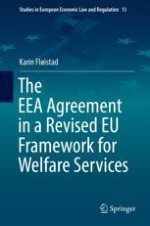2018 | OriginalPaper | Chapter
6. Free Movement of Persons and Articles 45, 48 and 21 TFEU and Articles 28 and 29 EEA
Author : Karin Fløistad
Published in: The EEA Agreement in a Revised EU Framework for Welfare Services
Publisher: Springer International Publishing
Activate our intelligent search to find suitable subject content or patents.
Select sections of text to find matching patents with Artificial Intelligence. powered by
Select sections of text to find additional relevant content using AI-assisted search. powered by
